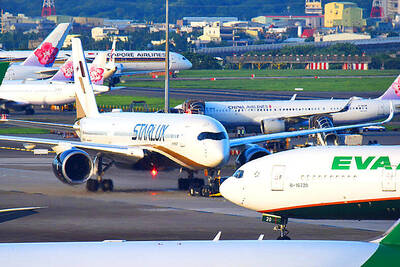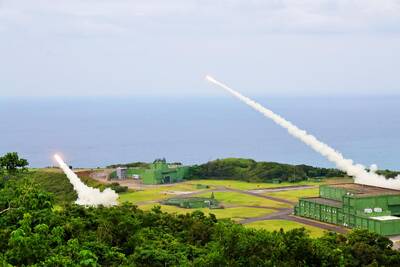The latest poll by National Chengchi University’s Election Study Center showed a record-low 9.1 percent of respondents support unification with China, and a record-low 3.3 percent regard themselves as Chinese.
The poll is part of a study that has been ongoing since 1992 on political attitudes, including on the unification-independence issue, national identity and political party preference.
The latest figures, gathered last month, showed that 59 percent of respondents identify themselves as Taiwanese, a slight drop from 60.6 percent in December last year.
The poll found 33.7 percent of respondents said they are both Taiwanese and Chinese, increasing slightly from 32.5 percent last year, and those identifying themselves as solely Chinese dropped to a historical low of 3.3 percent.
The poll found 21.1 percent of respondents said they support Taiwanese independence or would favor an immediate declaration of independence, lower than 23.9 percent last year.
The number of people who support unification or lean toward immediate unification reached a historical low of 9.1 percent.
Support for the Democratic Progressive Party (DPP) has risen from 26.7 percent last year to a record-high 29.7 percent, while support for the Chinese Nationalist Party (KMT) dropped from 22.9 percent last year to 21 percent, its lowest since 2003.
Support for the People First Party increased from 2.7 percent last year to 3.9 percent this year, the highest since 2006.
Saying that the data showed the long-term tendency of Taiwanese core attitudes and identifications, DPP Legislator Lee Chun-yi (李俊俋) said the percentage of people who identify themselves as Taiwanese has soared from 48.4 percent in 2008 to 59 percent this year due to a series of pro-China policies launched by President Ma Ying-jeou (馬英九) since he took office in 2008.
The number of people who regard themselves as Chinese has fallen from 4 percent in 2008 to 3.3 percent this year and has yet to hit the bottom, which shows that the Taiwanese do not want Taiwan to be a part of China, Lee said.
Support for the KMT has plummeted from the historical high of 39.5 percent in 2011 to 21 percent this year, while support for the DPP has steadily climbed from 19.5 percent in 2009 to 29.7 percent this year, he said.
The rise and fall are the results of the KMT’s poor performance and the DPP’s ability to put forward clear policies and define the direction of reform, such as the proposal of developing renewable resources to bring about a nuclear-free homeland and an elaborated platform of the long-term care to provide for the aging population, he said.
However, the KMT and the Ma administration have turned their backs on public opinion, which is evident in a forceful implementation of a set of high-school curriculum guidelines that critics said are unprofessional and historically incorrect, while the government insists on pressing charges against students who stormed the headquarters of the Ministry of Education in Taipei on Thursday to protest against the curriculum, Lee said.

Trips for more than 100,000 international and domestic air travelers could be disrupted as China launches a military exercise around Taiwan today, Taiwan’s Civil Aviation Administration (CAA) said yesterday. The exercise could affect nearly 900 flights scheduled to enter the Taipei Flight Information Region (FIR) during the exercise window, it added. A notice issued by the Chinese Civil Aviation Administration showed there would be seven temporary zones around the Taiwan Strait which would be used for live-fire exercises, lasting from 8am to 6pm today. All aircraft are prohibited from entering during exercise, it says. Taipei FIR has 14 international air routes and

Taiwan lacks effective and cost-efficient armaments to intercept rockets, making the planned “T-Dome” interception system necessary, two experts said on Tuesday. The concerns were raised after China’s military fired two waves of rockets during live-fire drills around Taiwan on Tuesday, part of two-day exercises code-named “Justice Mission 2025.” The first wave involved 17 rockets launched at 9am from Pingtan in China’s Fujian Province, according to Lieutenant General Hsieh Jih-sheng (謝日升) of the Office of the Deputy Chief of the General Staff for Intelligence at the Ministry of National Defense. Those rockets landed 70 nautical miles (129.6km) northeast of Keelung without flying over Taiwan,

City buses in Taipei and New Taipei City, as well as the Taipei MRT, would on Saturday begin accepting QR code payments from five electronic payment providers, the Taipei Department of Transportation said yesterday. The new option would allow passengers to use the “transportation QR code” feature from EasyWallet, iPass Money, iCash Pay, Jkopay or PXPay Plus. Passengers should open their preferred electronic payment app, select the “transportation code” — not the regular payment code — unlock it, and scan the code at ticket readers or gates, General Planning Division Director-General Liu Kuo-chu (劉國著) said. People should move through the

The Ministry of National Defense (MND) today released images of the military tracking China’s People's Liberation Army (PLA) movements during the latest round of Chinese drills around Taiwan. The PLA began "Justice Mission 2025" drills today, carrying out live-fire drills, simulated strikes on land and maritime targets, and exercises to blockade the nation's main ports. The exercises are to continue tomorrow, with the PLA announcing sea and air space restrictions for five zones around Taiwan for 10 hours starting from 8:30am. The ministry today released images showing a Chinese J-16 fighter jet tracked by a F-16V Block 20 jet and the